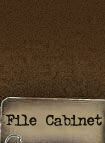|

Case Title: Battle of
Kloosterdreef
Subject: Capture of two
German 88mm canons by "F"
Co/506th
Date: September 18th, 1944
Location: Eindhoven,
Holland
Introduction: The capture
of two German 88 millimeter
canons on the Eindhoven streets
named Klooster Dreef and
Woenselsche Straat has been well
documented in the history books
as well as in the 101st Airborne
Division's After Action Reports.
The location of this battle,
decisive for the liberation of
the Southern Dutch city has
changed beyond recognition over
the years. Battle detectives
reconstructed the battlefield.
(click on the
images to enlarge)
|
|
 |
|
Eindhoven, September 18th 1944
Paratoopers of 2nd Bn have taken an
alternative route South and are now
circling North towards the two 88mm
guns that hold op the main advance.
At the corner of Kloosterdreef they
pause to regroup.
|
|
 |
|
Eindhoven, September 18th 1944
At the same corner they gather some
POW's and wait until a substantial
force is ready to move North towards
the guns.
|
|
 |
|
Eindhoven, winter of 1943-1944
A civilian photographer took this
picture of what the German crew of
the Southern most 88 mm wouls see a
few months later when they looked
East on Klooster Dreef.
|
|
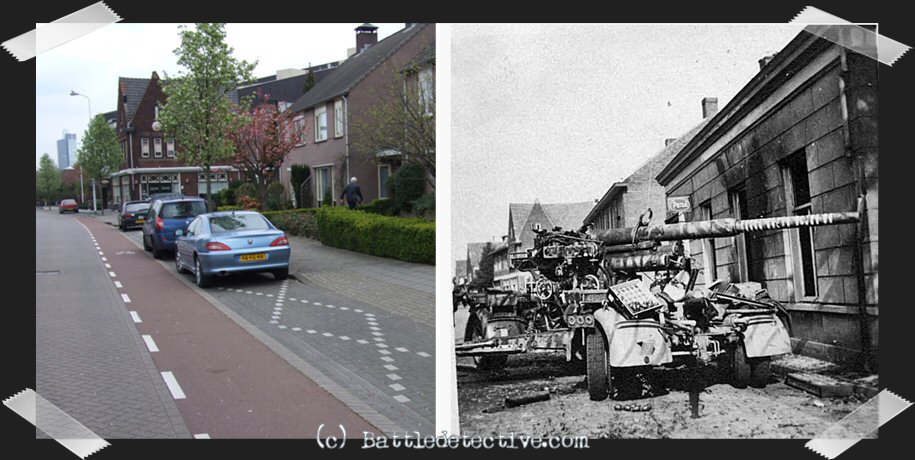 |
|
Eindhoven, September 18th 1944
The Northernmost 88 mm gun. The
German crew blew the breech when
faced with paratroopers from both
sides. The "X" on the street in the
"Now"-picture seems to mark the spot
where the gun stood.
|
|
 |
|
Eindhoven, September 18th 1944
A wounded German Luftwaffe gun crew
member lies wounded on the curb
after the Battle of Kloosterdreef is
over. |
|
 |
|
Eindhoven, September 18th, 1944
After "F"-Co./506th took out the two
88mm guns that slowed down the
Regiment's advance into Eindhoven,
citizens take a look at the gun on
Kloosterdreef.
|
|
 |
|
Eindhoven, September 18th 1944
After the link-up between the U.S.
paratroopers and the British Guards
Armoured Division, a scout car stops
on Woenselsestraat, just North of
the captured 88mm guns. |
|
Woensel, the North-Eindhoven suburb,
has changed drastically since 1944
but nevertheless, by analyzing After
Action Reports, photographs and maps
from archives and interviews with
eyewitnesses, Battledetective was
able to reconstruct the scene of
the Battle of Kloosterdreef.
|
|
(Click on the image
to enlarge)
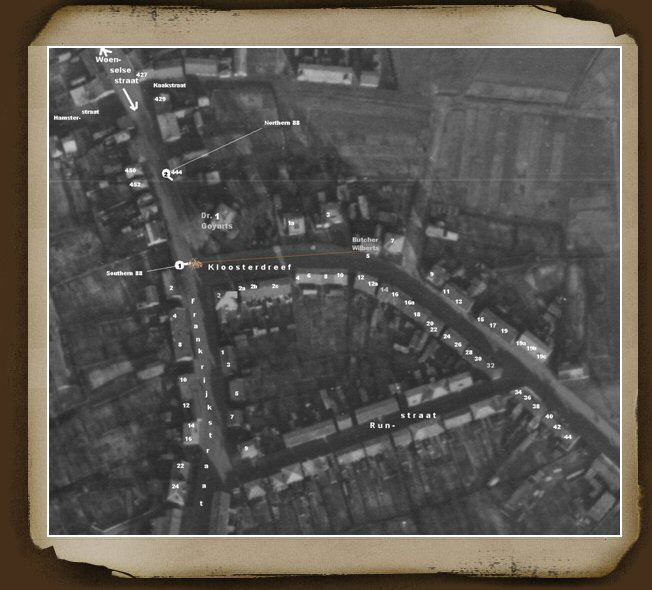
|
|
Reconstruction of the block as it
was in September 1944
As the above aerial photographs
prove, many houses on Klooster Dreef
and Woenselse Straat were
demolished after the war, to create
the wide Europa Laan and Dr. Berlage
Laan.
We have, however, obtained archived
photographs of all the destroyed
houses. Also we took photo-
graphs of the houses that are still
there. We have categorized the
photographs by street name and
residency number.
Roll mouse over the thumbnails for
descriptions of the images.
(Click on the images to enlarge) |
|

_small.jpg)
_small.jpg)
%20(1)%201960's_small.jpg)
%20(2)%201960's_small.jpg)

_small.jpg)
,%20Officer_small.jpg)
,%20Officer_small.jpg)
_small.jpg) _small.jpg)
_small.jpg)
_small.jpg)
,%20Wounded_small.jpg)
_small.jpg) _small.jpg)
,%20POW's_small.jpg)
,%20jeep_small.jpg)
,%20early%201900's_small.jpg)
,%201920's_small.jpg) ,%201920's_small.jpg)
,%201960's_small.jpg)

,%20resting%20lieutenant_small.jpg)

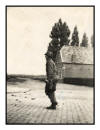
_small.jpg)
_small.jpg)
_small.jpg)
_small.jpg)
_small.jpg)



_small.jpg)
_small.jpg)
%20Butcher%20Wilberts%20Damage_small.jpg)
%20Butcher%20Wilberts%20Damage_small.jpg)
%20Butcher%20Wilberts%20Damage_small.jpg)
%20Butcher%20Wilberts%20Wedding%201960's_small.jpg)
,%201960's_small.jpg)





%20_small.jpg)
%20_small.jpg)
,%201960's_small.jpg)
%20Kloosterdreef%2019c_small.JPG) _small.jpg)
%20_small.jpg)
%20_small.jpg)




 _small.jpg)
_small.jpg)
_small.jpg)
_small.jpg)


_small.jpg)
_small.jpg)
_small.jpg)
_small.jpg)
_small.jpg)
_small.jpg)
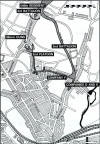
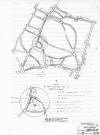

 |
|
August, 2008 UPDATE: NEW PHOTOGRAPHIC EVIDENCE!
Until now, we have always
assumed that the Southern-most 88 millimeter gun 'only'
damaged the Wilberts'
butcher shop. Recently, we received a copy of a picture of
the residences on Klooster Dreefnumbers 2 A & B
from Petra Wenstedt-Pulles. The gables of these houses have
been damaged by at least two rounds fired by
the 88 aiming at SGT Taylor's squad. Below is the
photograph. The house on the right is Klooster Dreef 2A.
The Karel Family lived there. Fortunately, the Karels's were
not in the house when it was damaged.
Next door was number 2B of the Van den Heuvel Family. It is
unknown to us, if they were inside their home
when it was hit.
This image sheds new light on the intensity of the Battle of
Klooster Dreef.
(Click on the image for a high resolution
version)
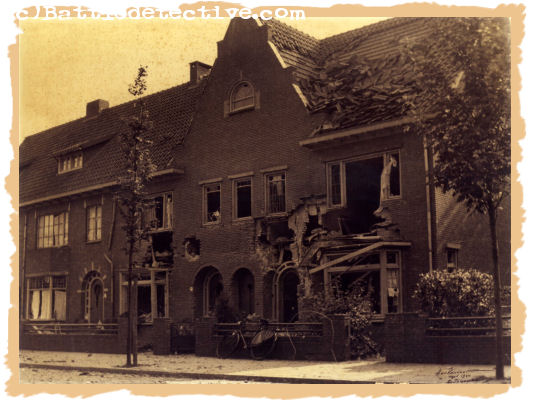 |
|
March, 2009 UPDATE: Original Klooster Dreef
bricks surface from underneath asphalt street top!
The City of Eindhoven has hired
road construction contractors to add a new asphalt top on
several of its streets. Also the tops of Klooster Dreef and
its stretch which today is named Europa Laan, needed a new
layer of black tarmac.
After the old cracked top was
removed, the original brick road which once was Klooster
Dreef saw daylight again. A piece of fine urban archeology
from a team of orange clad construction workers.
With our camera-phone we took
this snapshot on March 17th, right after workmen left the
last stretch of unearthed brick road exposed (note sun
setting low):

It shows the original brick road so characteristic for Klooster Dreef
during the battle described in this Case File. At the base
of the tall building in the upper right corner of the
photograph was the position of the Southern 88. The butcher
shop behind which SGT Taylor took cover was near the bicycle
at right. The damaged house in our August, 2008 Update is
right behind the white van at top left.
The next day we returned with a better camera only to find
the original bricks buried again:
.jpg)
This is the same corner in a
Now&Then comparison:
(click on the
image for a larger picture)
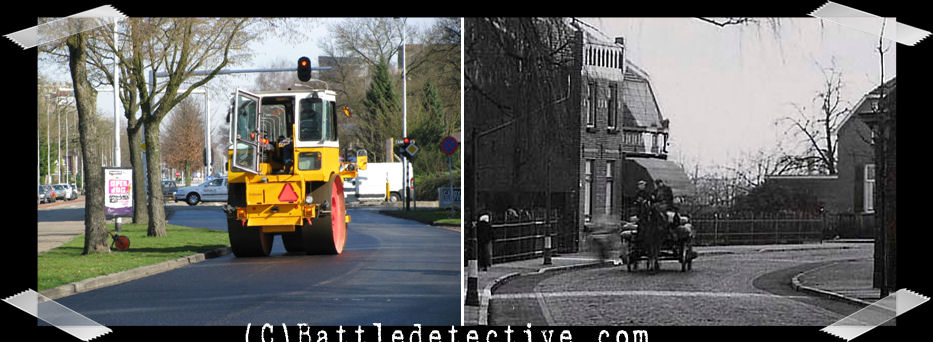
With the new asphalt top in place, not a
single clue is left that this was the same bend in Klooster
Dreef
When we arrived on Klooster
Dreef, the construction men where just finishing the new
black top near the old Dr. Goyart's house:
.jpg)
We did find some chips of the
old brick road next to the brand new, steaming hot road:
.jpg)
(click on the thumbnails for a larger
picture)

_small.jpg)
_small.jpg)
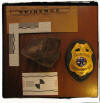
Our battledetectives did,
however, talk to Mr. J. Hermans, one of the foremen of the construction
company and explained our interest in this stretch of Europa
Laan. Hermans turned out to have an interest in old road
construction techniques. He had taken several photographs of
the old brick pavement in Europa Laan and Kloosterdreef in
the previous days. E-mail addresses were exchanged and
several days later we received a complete pictorial report
of the road deck reconstruction project. This is a
selection:
(click on the thumbnails for larger pictures)
_small.jpg)
_small.jpg)
_small.jpg)
_small.jpg)
_small.jpg)
|
|
June 4th, 2009 UPDATE:
Battledetectives pose with an 88 millimeter canon
On the grounds of the Dead Man’s Corner Museum near Sainte-Côme-du-Mont
in Normandy we found this 88 millimeter canon:

Battle detective Tom poses next to the aiming
devices of the canon
It is a
Spanish made artillery piece produced in 1948:
.jpg)
Nevertheless it is an almost
exact replica of the 88 millimeter dual purpose (both
anti-aircraft and anti-tank) canons that "F"-Co/506th put
out of action as described in this Case File. It gives a
good impression of the size of the guns.
.jpg)
Battle detectives Ivo and Tom 'man' the 88 |
|
June 12th,
2009 UPDATE
Through our contact form
we received some comments on the photographs used in this
Case File. Dutchman Hans van Melis explained that a
photograph - of which we captioned it as being taken into
Wezel Straat - is in fact 'shot' into Kroenehoef Straat.
Hans wrote:
"Wonderful page and foto's ONE error:" and included
this comprehensive diagram:
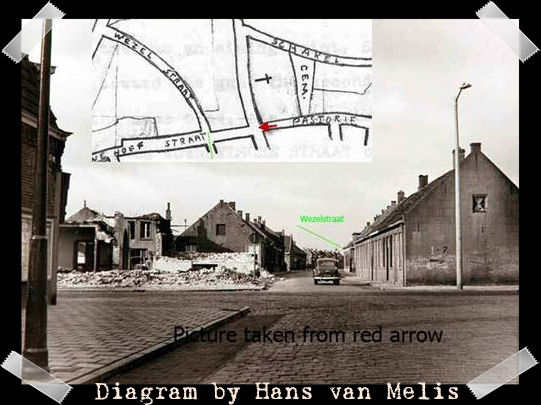
In a subsequent e-mail Hans also
explained this about "The lone paratrooper":
 |
|
[He] Walks from east to west on the
Kloosterdreef see:
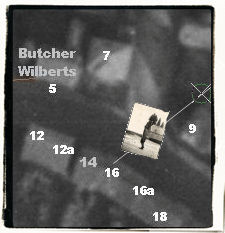
(section of the aerial photograph with
house numbers) De Kuster [Family] lived on Kloosterdreef 16. The
house on the right is Kloosterdreef 9.
Some of the pictures on the site are from the 'ouwwoensel'
website, taken by Eugene de Vries. |
|
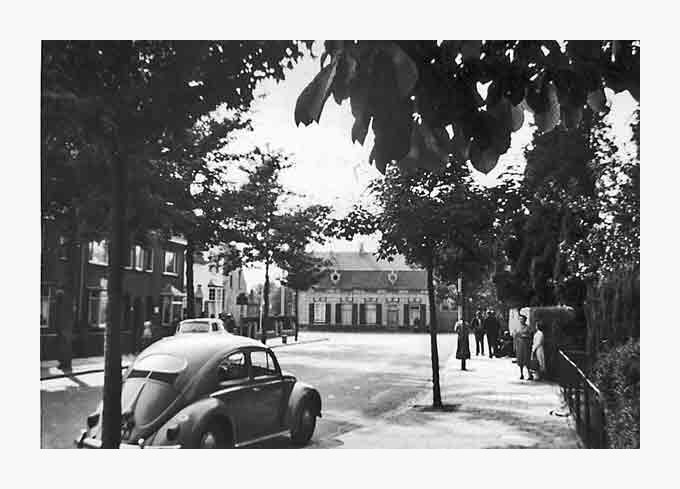
In the back [is] his grandfather’s house where the
88 was positioned[.]
The grey wall left is:
,%20POW's.jpg)
We thank Mr. van
Melis for sharing this much appreciated knowledge. |
|
December 13th, 2022 UPDATE
Identification of German unit of the 88 millimeter canon
crews
In the hardcover publication "Autum Gale / Herbststurm",
Kampfgruppe Chill, schwere Heeres Panzer-jäger-Abteilung 559
and the German recovery in the autumn of 1944", by Jack
Didden and Maarten Swarts, Zwaardvisch Publishers 2013, ISBN
978-90-800393-8-4 (www.autumngale.com),
on page 202- 203 of subchapter "The Screaming Eagles" we
read:
"The 506th was partly successful that first day. Because
they knew that time was at a premium Colonel Sink and the CO
of his 1st Battalion, Major James L. LaPrade, decided to
gather their men in groups of about twenty after landing and
sending them on their way. After the 1st Battalion had taken
the bridge at Son the rest of the 506th would cross and
advance into Eindhoven. In order to surprise the German
defences at the bridge LaPrade decided not to use the road,
but move through the woods slightly to the west. Once he hit
the Wilhelminakanaal he would turn left and take the
defenders from the flank. He would never get that far. At
Zonhoven he came upon two 8.8 cm Flak guns from 4./schwere
Flak-Abteilung 428 which immediately and with deadly
accuracy opened fire on his battalion (end note 741).
Despite severe casualties the Paratroopers managed to take
the position and move on. Meanwhile the 2nd and 3rd
Battalions had reached Son via the main road. As they neared
the bridge they, too, were fired upon by another 88
from 4./s.Fl.Abt. 428."
End note 741:
KTB88 AK, 18.09.44 A 339 lists the locations and
strengths of 428. At Son 4./428 it had six 8.8 cm and
3 2cm guns.
This is the original entry in the German 88th Army Corps War
Diary about 4./428 on 18SEP1944:

Translation: 4./428 6/8.8 cm, 3/2 cm
deployed canal bridge Son, fate unknown
The abbreviated unit designation
translates as 4th Battery of the 428th Heavy
Anti-Aircraft Artillery Battalion (German Air Force).
Page 217 of subchapter "The
liberation of Eindhoven": The advance slowed down. The first
real trouble occurred when the lead Paratroopers passed the
first houses of Woensel at about nine a.m. Shells from what
were obviously an 88 began to crash down. The
Paratroopers spread out and found cover. In the distance
they could just make out the Flak gun firing at them.
Unknown to the Americans, there was a second gun slightly
behind and to the left of the first one. Both were in fact
part of Kampfgruppe Köppel.”
In the hardcover publication "Kampfgruppe
Walther and Panzerbrigade 107, A thorn in the side of Market
Garden", by Jack Didden and Maarten Swarts, Zwaardvisch
Publishers 2016, ISBN 978-90-800393-9-1,
on pages 91 and 92 it is repeated that the 88 millimeter
guns in Son belonged to 4./schwere Flak-Abteilung
428 and on pages 106 and 107 the authors again write
that the 88 millimeter guns in Woensel belonged to
Kampfgruppe Köppel.
|
Hand-drawn map of German artillery dispositions by Dutch
resistance
On the website Eindhoven4044 we found a section about the
Dutch Partizanen Actie Nederland resistance organization.
For this organization see also this agency’s
Battle Relic #3 article.
The website has published a handmade diagram of the gun
positions in Son made by PAN-members:
|
|
(click to enlarge)
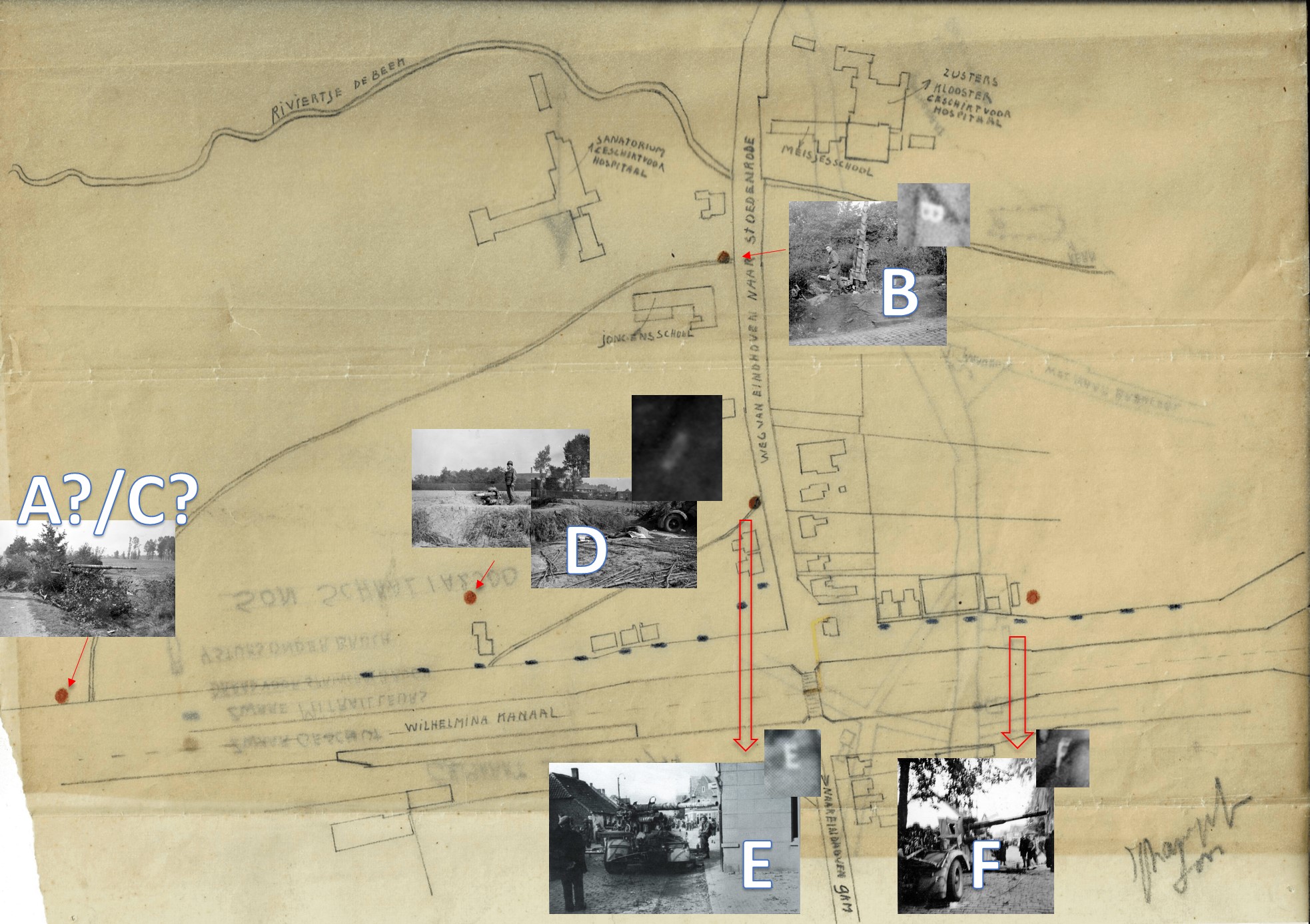
Source:
https://www.eindhoven4044.nl/50/assets/images/scan-kaartjes-14-1742x1229.png
on https://www.eindhoven4044.nl/50/gevechtskaartjes.html
visited on 09DEC2022 |
We plotted the various guns seen on photos taken in Son and
Eindhoven on 17 and 18SEP1944 on the diagram. It should be
noted that the previous deployment locations of guns "E" and
"F" in Son on Nieuwstraat and at the North canal bank east
of the bridge are tentative and based on assumption.
|
Analysis
From the PAN resistance organization map, the photos taken
on 17 & 18 SEP1944 of the various 88 millimeter Flak guns in
Son and Eindhoven, the information from the War Dairy of the
German 88th Army Corps and the books "Autum Gale /
Herbststurm" and "Kampfgruppe Walther and Panzerbrigade
107", it can be deduced that guns "E" and "F" on
Woenselsestraat on 18SEP1944 belonged to 4./schwere Flak-Abteilung
428. The reason for listing their affiliation (also) to
Kampfgruppe Köppel is presumably because this was how
the Luftwaffe Flak-Brigade XVIII was indicated. It is
assumed by this agency that schwere Flak-Abteilung 428 was
part of that Brigade/Kampfgruppe.
In terms of "whodunit" detective investigations we are now
able to identify who or rather, which German unit, wounded
paratrooper Bill Galbraight and did damage to civilian
property on Nieuwstraat in Son and on Kloosterdreef in
Eindhoven on 17&18SEP1944. |
|

Back to
Case Files

|


